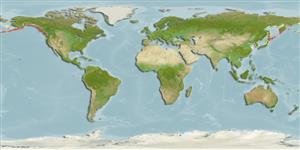Common names from other countries
Classification / Names / Names
Common names | Synonyms | Catalog of Fishes (gen., sp.) | ITIS | CoL | WoRMS
Environment: milieu / climate zone / depth range / distribution range
Ecology
Benthic; depth range 0 - 40 m (Ref. 289). Polar
Arctic and Northern Pacific. Polar to boreal.
Length at first maturity / Size / Weight / Age
Maturity: Lm ? range ? - ? cm Max length : 1.7 cm TL male/unsexed; (Ref. 283)
Most common in oyster beds and among growths of algae (Ref. 290). Girdle: narrow; closely beset with minute spines but appearing almost smooth to the naked eye. Surface: Smooth but under a lens the valves are finely granulated in quincunx. Lateral areas: Scarcely defined. Valve color: Olive-brown, streaked, maculated or clouded with blue or chestnut (Ref. 297).
Depth based on occurrence record; to be replaced with better reference. Most common in oyster beds and among growths of algae (Ref. 290). Found from subtidal to 40 m (Refs. 289, 75835).
Life cycle and mating behavior
Maturity | Reproduction | Spawning | Eggs | Fecundity | Larvae
Members of the class Polyplacophora are mostly gonochoric. Life cycle: Eggs hatch into lecitotrophic planktonic trocophore larvae (no veliger stage) which later metamorphose and settle on the bottom as young adults.
Slieker, F.J.A. 2004. (Ref. 289)
IUCN Red List Status (Ref. 130435)
CITES status (Ref. 108899)
Not Evaluated
Not Evaluated
Human uses
| FishSource |
Tools
More information
Age/SizeGrowthLength-weightLength-lengthMorphologyLarvaeAbundance
Internet sources
Estimates based on models
Preferred temperature
(Ref.
115969): 4.1 - 10, mean 7 (based on 108 cells).
Vulnerability
Low vulnerability (10 of 100).
Price category
Unknown.
